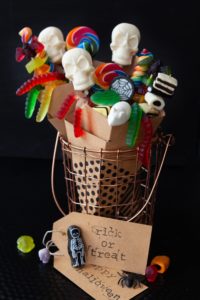Many parents are anxious about the safety of their children while trick-or-treating on Halloween, especially during the COVID-19 pandemic. Parents whose children have food allergies have an additional concern – will my children be exposed to the foods they’re allergic to?

Peanuts and milk, both common candy ingredients, are among the top nine foods that trigger most allergic reactions. For many children with food allergies, candy is simply off-limits. Particularly on Halloween, candy is likely to mingle and cross-contaminate. Many children with food allergies are simply unable to participate in this holiday.
As you decide what to hand out this Halloween, be sure to think about trick-or-treaters who may have a food allergy. By doing so, you can help include them in the fun!
Alternatives to Halloween candy
Consider offering non-food treats, such as:
- glow sticks
- stickers
- vampire fangs
- bubbles
- For more non-food item inspiration, click here.
The Teal Pumpkin Project
To promote your allergy awareness, place a teal-painted pumpkin outside your door, or print a free sign to hang in front of your home. The “Teal Pumpkin Project,” created by a Tennessee mother who wanted to give her child with food allergies the ability to join in the Halloween festivities, is currently in its ninth year. The Teal Pumpkin advertises that your home has non-food treats to give. There are Teal Pumpkin Project participants in all fifty states. You can sign up here to receive a map of participating households in your neighborhood.

Trick-of treating tips for food allergies
For parents of children with food allergies, the following tips can also help to keep Halloween safe:
- Always read the ingredient label
- Be aware that even if it isn’t listed on the ingredient label, candy is at high risk of containing trace amounts of allergy triggers
- Know that “fun size” candies may be made on different equipment than the regular size candies, and can lead to an unexpected reaction
- Talk to your child about turning down home-baked items
Halloween COVID safety
For families choosing to trick-or-treat this year, make sure to keep safe distances, carry hand sanitizer and wipes, and consider wearing masks if age-appropriate. Limiting trick-or-treating to a small number of homes, and handing out individual food and non-food goodie bags can help too. If you opt to forego trick-or-treating in the community this year, there are plenty of fun activities that you can do at home, including hiding candy around your house for your children to find!
With just a little awareness and effort, everyone can help make Halloween a holiday all children can enjoy. For more information about food allergies, visit FARE’s website.



